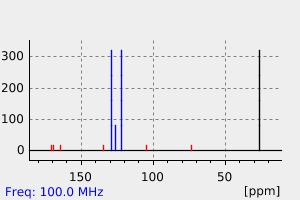5-[(hydroxy)(phenylamino)methylidene]-2,2-dimethyl-1,3-dioxane-4,6-dione | 261639-91-2
中文名称
——
中文别名
——
英文名称
5-[(hydroxy)(phenylamino)methylidene]-2,2-dimethyl-1,3-dioxane-4,6-dione
英文别名
5-[hydroxy(phenylamino)methylene]-2,2-dimethyl-1,3-dioxane-4,6-dione;5-(α-phenylamino-α'-hydroxy)methylene Meldrum's acid;5-[hydroxy(phenylamino)methylene]-2,2-dimethyl-1,3-dioxa-4,6-dione;Meldrum's acid anilide;5-[anilino(hydroxy)methylene]-2,2-dimethyl-1,3-dioxane-4,6-dione
CAS
261639-91-2
化学式
C13H13NO5
mdl
——
分子量
263.25
InChiKey
KNHWHZSDFCNQTM-UHFFFAOYSA-N
BEILSTEIN
——
EINECS
——
-
物化性质
-
计算性质
-
ADMET
-
安全信息
-
SDS
-
制备方法与用途
-
上下游信息
-
文献信息
-
表征谱图
-
同类化合物
-
相关功能分类
-
相关结构分类
物化性质
-
熔点:105-107 °C(Solv: ethyl acetate (141-78-6))
-
沸点:459.0±45.0 °C(Predicted)
-
密度:1.384±0.06 g/cm3(Predicted)
计算性质
-
辛醇/水分配系数(LogP):1.7
-
重原子数:19.0
-
可旋转键数:2.0
-
环数:2.0
-
sp3杂化的碳原子比例:0.23
-
拓扑面积:84.86
-
氢给体数:2.0
-
氢受体数:6.0
反应信息
-
作为反应物:参考文献:名称:TMSCl 作为胺与 5-(α-氨基-α'-羟基) 亚甲基 Meldrum 酸酰化的加速添加剂摘要:摘要 介绍了胺、醇和硫醇与 5-(α-氨基-α'-羟基) 亚甲基 Meldrum 酸的酰化反应。我们特别强调仲胺与 5-(α-氨基-α'-羟基) 亚甲基 Meldrum 酸的酰化反应,由于它们的碱性,导致与 Meldrum 酸衍生物形成盐的问题。我们发现仲胺与 5-(α-氨基-α'-羟基) 亚甲基 Meldrum 酸反应速度最慢且收率低,在 1 到 3 的情况下与相同的试剂反应迅速且收率高相当于 TMSCl。针对诸如反应温度、溶剂极性和环境酸度等因素优化了用这种 Meldrum 酸衍生物的酰化。我们已经制备了多种非对称丙二酸二酰胺、酯、和丙二酸的硫酯。图形概要DOI:10.1080/00397911.2010.533805
-
作为产物:参考文献:名称:在氯三甲基硅烷(Me3SiCl)存在下,胺与5-[((芳基或烷基氨基)羟基亚甲基] -2-,2-二甲基-1,3-二恶烷-4,6-二酮)反应的机理摘要:将氯三甲基硅烷(Me 3 SiCl)添加到氨基甲酰基取代的麦德鲁姆酸的混合物中,即5-[[(芳基氨基)羟基亚甲基] -2-,2-二甲基-1,3-二恶烷-4,6-二酮1型胺和仲胺作为亲核试剂强烈地促进了它们的反应速度。然而,在我们之前的研究中,仍观察到这种现象的原因尚不清楚。为了阐明该反应的机制,我们假定和验证三种可能的途径为我的动作3的SiCl(参见方案2):该反应的加速度引起我通过形成的)Ô -trimethylsilylated麦德鲁姆2的酸,ii)被甲硅烷基化的胺3所取代,或iii)在从Me 3 SiCl中释放出的HCl的存在下。进行的实验表明,更快的反应过程是由3型N-三甲基甲硅烷基化胺的形成引起的。DOI:10.1002/hlca.201200326
文献信息
-
One-Step Synthesis of β-Lactams with Retro-Amide Side Chain作者:Sławomir Makowiec、Karolina Janikowska、Natalia PawelskaDOI:10.1055/s-0030-1258966日期:2011.1A one-pot synthesis for the preparation of 1,4-disubstituted 2-oxoazetidine-3-carboxylic acid amides was developed. 5-[(N-substituted-amino)(hydroxy)methylene] Meldrum’s acids act as a source of ketenes that react with aldimines in boiling toluene to give β-lactams with a retro-amide side chain.
-
Thermal Decomposition of Carbamoyl Meldrum's Acids: A Starting Point for the Preparation of 1,3-Oxazine Derivatives作者:Sławomir Makowiec、Ewelina Najda、Karolina JanikowskaDOI:10.1002/jhet.2028日期:2015.1The ability to undergo [4 + 2] versus [2 + 2] cycloaddition was under investigation for ketenes thermally generated from carbamoyl Meldrum's acid. Usually, 1,3‐oxazino‐5‐carbamoylo‐4,6‐diones are formed when carbamoyl Meldrum's acid reacts with imine. However, in some cases, a reaction takes an unexpected course, leading to the formation of tetraponerines alkaloids derivatives or cyclic iminoethers.
-
A new approach to the stereoselective synthesis of trans-3-carbamoyl-β-lactam moieties作者:Anna Zakaszewska、Ewelina Najda-Mocarska、Sławomir MakowiecDOI:10.1039/c7nj00445a日期:——One-pot synthesis of optically active 1,4-disubstituted-3-carbamoyl-azetidinones from 5-[(N-arylamino)(hydroxyl)methylene]-2,2-dimethyl-1,3-dioxa-4,6-diones and chiral aldimines is achieved via thermal generation of carbamoyl ketenes and subsequent [2+2] cycloaddition. Three possible chiral induction approaches were tested and (R)-(+)-1-phenylethylamine was confirmed as the best chiral auxiliary. Among
-
Reactions of Enols of Amides with Diazomethane作者:Yi Xiong Lei、Zvi RappoportDOI:10.1021/jo0203802日期:2002.10.1analogue 11 reacted with three diazomethane molecules and underwent a ring expansion and O-methylation to the 3-anilido-1,4-dimethoxynaphthalene. It is suggested that the reaction initiates by protonation of the diazomethane by the enol and an approximate qualitative relationship exists between the acidity of the enol and K(enol) and the regioselectivity of the reaction.研究了被两个β-吸电子基团活化的10种羧酰胺与重氮甲烷的反应,这些基团大多数以其烯醇形式全部或部分存在。主要结果是观察到的反应的多样性。对于被至少一个三氟乙氧基羰基或氰基活化的最酸性的烯醇3-7,发生O-甲基化或O,N-二甲基化。对于β-二甲氧基羰基活化的系统5和8,酰胺形式的C-甲基化产物是产物之一。与Meldrum的酸苯胺烯醇2发生裂解,导致C-烷基化的亚胺具有CH(CO(2)Me)(2)基团。Me(2)CHNHC(OH)[双键] C(CO(2)CH(2)CF(3))的C,N-二甲基化产物中的甲氧基羰基交换一个2,2,2-三氟乙氧基羰基( 2)4发生了。2-anilido-1,3-环戊二酮10在羰基环上被甲基化,而1,3-茚满二酮类似物11的烯醇与三个重氮甲烷分子反应并进行扩环和O-甲基化为3-苯胺基-1,4-二甲氧基萘。建议该反应通过烯醇使重氮甲烷质子化而引发,并且烯醇和K(烯醇)的
-
Evidence for an umpolung type of [2+2] cycloaddition of 2-carbamoyl ketenes作者:Anna Zakaszewska、Ewelina Najda-Mocarska、Sławomir MakowiecDOI:10.1039/c7nj00830a日期:——Ketenes generated during the thermal decomposition of 5-[(N-aryl/alkylamino)(hydroxyl)methylene]-2,2-dimethyl-1,3-dioxa-4,6-diones react with highly electrophilic iminium ions. The initial [2+2] cycloaddition product rearranges to 2-arylidene malonamide. Mechanistic aspects of the process are presented.
表征谱图
-
氢谱1HNMR
-
质谱MS
-
碳谱13CNMR
-
红外IR
-
拉曼Raman
-
峰位数据
-
峰位匹配
-
表征信息
同类化合物
(乙腈)二氯镍(II)
(R)-(-)-α-甲基组胺二氢溴化物
(N-(2-甲基丙-2-烯-1-基)乙烷-1,2-二胺)
(4-(苄氧基)-2-(哌啶-1-基)吡啶咪丁-5-基)硼酸
(11-巯基十一烷基)-,,-三甲基溴化铵
鼠立死
鹿花菌素
鲸蜡醇硫酸酯DEA盐
鲸蜡硬脂基二甲基氯化铵
鲸蜡基胺氢氟酸盐
鲸蜡基二甲胺盐酸盐
高苯丙氨醇
高箱鲀毒素
高氯酸5-(二甲氨基)-1-({(E)-[4-(二甲氨基)苯基]甲亚基}氨基)-2-甲基吡啶正离子
高氯酸2-氯-1-({(E)-[4-(二甲氨基)苯基]甲亚基}氨基)-6-甲基吡啶正离子
高氯酸2-(丙烯酰基氧基)-N,N,N-三甲基乙铵
马诺地尔
马来酸氢十八烷酯
马来酸噻吗洛尔EP杂质C
马来酸噻吗洛尔
马来酸倍他司汀
顺式环己烷-1,3-二胺盐酸盐
顺式氯化锆二乙腈
顺式吡咯烷-3,4-二醇盐酸盐
顺式双(3-甲氧基丙腈)二氯铂(II)
顺式3,4-二氟吡咯烷盐酸盐
顺式1-甲基环丙烷1,2-二腈
顺式-二氯-反式-二乙酸-氨-环己胺合铂
顺式-二抗坏血酸(外消旋-1,2-二氨基环己烷)铂(II)水合物
顺式-N,2-二甲基环己胺
顺式-4-甲氧基-环己胺盐酸盐
顺式-4-环己烯-1.2-二胺
顺式-4-氨基-2,2,2-三氟乙酸环己酯
顺式-3-氨基环丁烷甲腈盐酸盐
顺式-2-羟基甲基-1-甲基-1-环己胺
顺式-2-甲基环己胺
顺式-2-(苯基氨基)环己醇
顺式-2-(苯基氨基)环己醇
顺式-2-(氨基甲基)-1-苯基环丙烷羧酸盐酸盐
顺式-1,3-二氨基环戊烷
顺式-1,2-环戊烷二胺二盐酸盐
顺式-1,2-环戊烷二胺
顺式-1,2-环丁腈
顺式-1,2-双氨甲基环己烷
顺式--N,N'-二甲基-1,2-环己二胺
顺式-(R,S)-1,2-二氨基环己烷铂硫酸盐
顺式-(2-氨基-环戊基)-甲醇
顺-2-戊烯腈
顺-1,3-环己烷二胺
顺-1,3-双(氨甲基)环己烷







